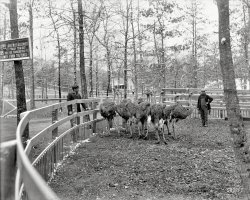
MAY CONTAIN NUTS

Search Shorpy
SHORPY ART

Framed or unframed, desk size to sofa size, printed by us in Arizona and Alabama since 2007. Explore now.
Join and Share
Ad-Free Shorpy
Shorpy is funded by you. Patreon contributors get an ad-free experience.
Learn more.

Recent comments
- Baldwin 62303
- Baldwin VO-1000
- Cold
- No expense spared
- Tough Guys
- Lost in Toyland
- And without gloves
- If I were a blindfolded time traveler
- Smoke Consumer Also Cooks
- Oh that stove!
- Possibly still there?
- What?!?
- $100 Reward
- Freeze Frame
- Texas Flyer wanted
- Just a Year Too Soon
- WWII -- Replacing men with women at the railroad crossing.
- Yes, Icing
- You kids drive me nuts!
- NOT An Easy Job
- I wonder
- Just add window boxes
- Icing Platform?
- Indiana Harbor Belt abides
- Freezing haze
- Corrections (for those who care)
- C&NW at Nelson
- Fallen Flags
- A dangerous job made worse
- Water Stop
Member Photos
The Shorpy
Print Emporium
Print Emporium
Search Shorpy
Search results -- 30 results per page
- American Gothic: 1935
- ... October 1935. "Rural rehabilitation clients. Boone County, Arkansas." 35mm negative by Ben Shahn for the Resettlement Administration. ... Posted by Dave - 07/05/2009 - 2:01am -
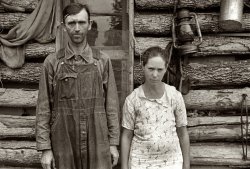
- Paper, Mister?
- ... in about 1928 or 29 on the square of small town Piggott, Arkansas. About 30 years later they would make the movie "A Face in the Crowd" ... Posted by Dave - 08/10/2010 - 11:38am
- Walk Your Horse: 1910
- Little Rock, Arkansas, circa 1910. "View from the Free Bridge." The sign: YOU MUST WALK YOUR ... The Fones building that was renovated as the Central Arkansas library is farther east (at 100 S. Rock Street). This one would have ... Posted by Dave - 08/14/2012 - 7:13pm -
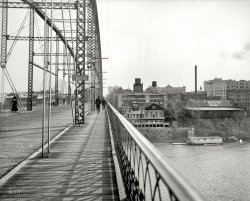
- Follow the Finger: 1908
- Hot Springs, Arkansas, circa 1908. "Army and Navy General Hospital." Closer to the camera on ... replaced in the 1950s by a V.A. facility that became the Arkansas Rehabilitation Center. I spent three months there in 1972 after ... Posted by Dave - 08/21/2012 - 11:19am -
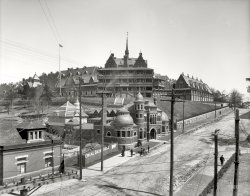
- Road Tripping: 1952
- ... before our previous photo was made at Eureka Springs, Arkansas. Where are we now? 35mm Kodachrome by Hubert Tuttle; paint by Dr. ... then, the way to get from Minnesota to Eureka Springs, Arkansas was along Highway 65. Given that people in 1952 didn't travel as far ... Posted by Dave - 09/02/2014 - 3:09pm -
![Road Tripping: 1952 "6 Oct 1952. Clara & Grace at chenille & souvenir shop south of _______ ." We're back with Hubert and Grace on their road trip from Minnesota, the day before our previous photo was made at Eureka Springs, Arkansas. Where are we now? 35mm Kodachrome by Hubert Tuttle; paint by Dr. Seuss. View full size.
JCT ASince the Missouri DOT doesn't have money to pave roads anymore, they have lots of time to do things like scan all of the old state highway maps. The '48/'49 and '53 maps confirm that there was never a Route T near Phillipsburg. In '49, Route T went all the way from Montreal (Missouri) to Route 66, but by '53, part of it was replaced by Missouri 35. The south end of that Route T being in Laclede County precludes there being another Route T in Laclede County that isn't connected to it.
My further guess would be that this is between Phillipsburg and Lebanon, because 1) the shadows say we are looking more or less north and 2) we can see the *backs* of signs that are advertising the wonders to be found to the south.
I spent a little time with Google Street View looking for that hill, but nothing jumped out at me. It's possible that the hill was eased when I-44 went through - the interstate would be pretty much right where Clara and Grace are standing.
How About This?Back then, the way to get from Minnesota to Eureka Springs, Arkansas was along Highway 65. Given that people in 1952 didn't travel as far in a day as we do, I'm going to guess this is around Sedalia, Missouri.
Not as rare a name as I thoughtI had thought that Wiltfong was a very rare name that might provide a location clue, but an online search shows well over 100 people with that surname. While they're located all over the place, there are a number in Missouri, which ties in with a prior comment. Someplace to the north of Eureka Springs also would make sense given the way the trees have turned more in this picture.
[What about "O. Wiltfong" -- are there hundreds of them? -Dave]
[Edit: No O's that I could find. Probably wouldn't matter, as the O in this picture has likely been long since gathered to his/her ancestors.]
[It does matter, if you're trying to figure out where this is. - Dave]
Country Roads Back when I was a lad, American highway lanes were separated by a white line (broken or solid as appropriate), as shown here. Somewhere along the line, the white of those lines was replaced with yellow, and white was retained only for separating same-direction lanes on multiple-lane roads. Apparently this was a change I completely slept through, because I can't place the time when it took place.
I wonder if anyone out there can pinpoint when this change occurred. The reason I'd like to know is that I find it irksome when "period" movies show yellow lines on putatively vintage roads (much like showing red/blue mailboxes in an era when they should be green), and I'd like to know at what portrayed period I can relax in this regard and, therefore, not feel an oppressing need to get a life.
[That bugs me in period movies, too. The change from white to yellow began in 1971 when the Federal Highway Administration assumed responsibility for the Manual on Uniform Traffic Control Devices. Everything you ever wanted to know about it is in this document. -tterrace]
I know where they are. Just outside of Hooterville.
Oliver!Oliver Wiltfong, born in 1900, was living in Blue Springs, Missouri, in 1920. In 1940, he was in St. Louis. Perhaps Ollie ended up at this roadside oddity by the time this pic was taken.
Route 66 Novelty MerchantThis is probably the home/business of Novelty Merchant Oliver U. Wiltfong in rural Lebanon area of Missouri.
Oliver (and wife Jessie) lived in rural Lebanon, Laclede County, Missouri, for about 2 years prior to Oliver's death from brain cancer on May 6, 1949.
They resided near Phillipsburg, a village of about 200 population southwest of Lebanon along U.S. Route 66 (now I-44). Postal address: Phillipsburg Rt I.
Assuming Jessie remained living in Phillipsburg after Oliver's death, at the time this photo was taken in 1952 I would venture to say this is probably the family home on Route 66 near Phillipsburg.
During the 1940/50s is was customary for folks living along Route 66 to sell novelties from their yards to passing travelers.
[The old Route 66, now State Highway W, parallels I-44 near Lebanon, Missouri, the town whose name fills in the blank in our caption. Below is Oliver's death certificate; click to enlarge. His address is given as Phillipsburg Route T, presumably State Highway T in the vicinity of Phillipsburg. - Dave]
[Dave - *Missouri T* is north of Lebanon. It runs south from Stoutland, MO to old Route 66 where it ends. Hence my conclusion the address on the Death Certificate is a U.S. Post Office mailing address (not a highway route). It's doubtful *Missouri T* ever ran all the way down to Phillipsburg, MO (unless since the 1940/50s the State renamed all the highways).
Common sense says to me that since Oliver sold novelties he would locate on old Route 66 for maximum traveler traffic. Few travelers ventured off of Route 66 particularly in rural areas (except to visit major attractions).
The building in the photo appears to be an old barn or shed dressed up a bit as a novelty shop by adding a false front and roof over hang. Notice the arched front vs. the pitched metal roof on the building; and, the double swinging barn type doors at the front of the building.
During the early to late 1950s my family traveled Route 66 annually from California to Missouri on vacations to visit family living in Missouri. The highway shown in the photo is what Route 66 was like most of the way from Chicago to California - a two lane concrete and/or asphalt highway.
The mail box with the name *O. Wiltfong* on it leads me to believe this is the property where Oliver and Jessie lived on old Route 66; and, that they converted an out building to a novelty shop.
All of this leads me to believe the photo was taken at the Wiltfong residence (and novelty shop) on old Route 66 in Phillipsburg, MO southwest of Lebanon, MO. - SilverfoxCo ]
(Minnesota Kodachromes, Travel & Vacation)](https://www.shorpy.com/files/images/SHORPY-MNK360A.thumbnail.jpg)
- Look Gives You Lemons: 1957
- October 1957. "The Lemon family of Little Rock, Arkansas -- father Fred, mother Edith, daughters Virginia and Rosemary, and son ... Interweb. I can locate only one obit for a Fred Lemon in Arkansas later than 1935, and this one seems to match up. Wife's name is right, ... Posted by Dave - 01/22/2014 - 1:48pm -
![Look Gives You Lemons: 1957 October 1957. "The Lemon family of Little Rock, Arkansas -- father Fred, mother Edith, daughters Virginia and Rosemary, and son Gary -- at home; in front of state capitol building; on streets of Little Rock." From photos by John Vachon for the Look magazine assignment "Members of the Mob." View full size.
The things you can findon the Interweb. I can locate only one obit for a Fred Lemon in Arkansas later than 1935, and this one seems to match up. Wife's name is right, and the cemetery is outside Little Rock.
1957? Little Rock?I assume this pictoral in Look had something to do with the events at Central High School. Were the sour Lemons possibly on the wrong side of history?
Mr. LemonI get the feeling that Mr. Lemon runs a very tight ship!
About this photoI'd like more information about this photo. Was father Fred here one of the "Members of the Mob"?
[The article "Members of the Mob" appeared in the "National Scene" section of the November 12, 1957 issue of LOOK, along with the article "The Real Little Rock Story," by Fletcher Knebel. -tterrace]
The SonLater went in to the small roadside motel business. He's very Hitchcocky.
September 5, 1957Beatcomber - I'm sure you are correct. It was a terrible time. My own mother was in that mob.
(John Vachon, LOOK, TV)](https://www.shorpy.com/files/images/SHORPY_02204u.thumbnail.jpg)
- Porch of Plenty: 1957
- ... nurse for 20 years in Iowa, continuing after a move to Arkansas in 1984. After that she got her real estate license and worked for a ... Posted by Dave - 12/02/2019 - 1:52am -
![Porch of Plenty: 1957 September 1957. "The Willis Cooper family on the front porch of their farmhouse near Radcliffe, Iowa, surrounded by animals and foods." 35mm color transparency from photos by Jim Hansen for the Look magazine assignment "Iowa family." View full size.
What the heckLooks like moving day.
American GothicRedux.
Interesting ladyhttp://www.funeralmation.com/index.cfm/obituary/4148225?browse_on=deskto...
Looks just like WilburCute little shoat he's holding there, and should be ready for slaughter this time next year.
Can we notI hate to be the one to say it but this family took staged photos to the same insane levels they took canning and preserving. It didn't suffice that every surface in the kitchen was covered with production results, and new surfaces had to be created, only to be covered like the others. Now the jars are hanging on the front of the house. Enough is enough already, folks. Start eating it.
[This is the vision of some magazine art director (or “producer,” as they were called at Look). The compliant Coopers, along with their Mason jars, are mere props. - Dave]
The producer needed to sit down and have a cookie.
There's no accounting for tasteMy hat is off to the Look producer who set all this up. He gave us two fantastic photos.
American AgrarianBeautiful home, beautiful crops, beautiful livestock, beautiful family. Jefferson would have loved this. Makes me wonder what is down the cellar steps.
Over-produced (and I don't mean the food)I can remember, growing up, how often LOOK photos struck me as so obvious, set up and posed, that they shouted fake. Sophisticated older me realizes that ALL photos are set up, but the LOOK ones still shout at me.
The cat!If this were my family, I'd be the little guy holding the cat. I don't see any dogs, that's good.
[Why does that cat quack? - Dave]
An interesting couple and a good lifeEveryone should read the obituary of Mrs. Cooper that was linked by robstercraws. Most people would think that the Coopers simply farmed and stayed in one place, eventually moving into town or into a retirement home. But the Coopers farmed in four different communities in Iowa. Mrs. Cooper was a registered nurse, which I'm sure was helpful with kids in the home, and a farmer husband; she also worked as a hospital nurse for 20 years in Iowa, continuing after a move to Arkansas in 1984. After that she got her real estate license and worked for a broker. Then in retirement, the Coopers ran a quilting business. They also managed to get their private pilot's licenses during the 1970s, and flew a Cessna 172 for ten years.
There's not as much information about Willis Cooper, but we do know from Mrs. Cooper's obit that the Coopers' first home after marriage was at Childress Army Airfield in Childress, Texas, where bombardiers and navigators were trained during World War II.
All in all, a good long life.
Children of the CornI’ve been waiting for someone to say it. I mean, those unblinking twins. They’re sitting right under the corn, for goodness sake.
(Kodachromes, Agriculture, LOOK)](https://www.shorpy.com/files/images/SHORPY-19726u.thumbnail.jpg)
- Hotel Pullman: 1900
- Hot Springs, Arkansas, circa 1900. "The Hotel Pullman." HELP WANTED: Sidewalk jockey with ... Posted by Dave - 05/17/2014 - 11:42pm -
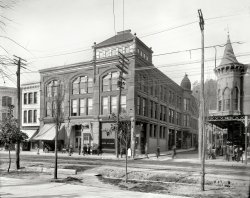
- Hill House: 1936
- ... the Southern Tenants Farmers Union were evicted from the Arkansas plantation of C.H. Dibble. Aside from the violence met by the ... Posted by Dave - 09/07/2018 - 11:55am -
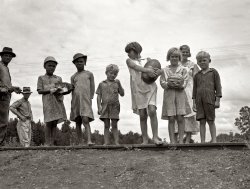
- Pure and Simple: 1958
- Little Rock, Arkansas, in 1958, in the midst of that city's school integration crisis. No ...
Everything is not as it seems My father was in the Arkansas National Guard during this, and my Aunt was a student at Central High ... Posted by Dave - 05/10/2013 - 6:59pm -
![Pure and Simple: 1958 Little Rock, Arkansas, in 1958, in the midst of that city's school integration crisis. No caption or photographer credit, but the picture tells the story. View full size.
Now with cheerleaderIronic that this is in black AND white.
MercuryI believe the car is a low-end 1957 Mercury. As for the politics, no comment necessary.
Very, very cute...the MG A, that is.
Everything is not as it seemsMy father was in the Arkansas National Guard during this, and my Aunt was a student at Central High School while this was going on. They both commented that while the basic facts of the situation were mostly as stated, most of the media accounts, pictures, film, were exaggerated, setups, or outright fakes. The media paid people to make banners like the ones above, among many other frauds. Not that they weren't willing but what actually showed up on TV or in the newspaper was not really the way it was.
[To suggest that "most of" the many thousands of news photos documenting the events of the late 1950s in Little Rock were set up or fake, or that these people were paid (by whom -- CBS News? Life magazine? The New York Times?) to make their signs, is ridiculous. - Dave]
British witnessIn the background, witness to this dismaying display, is an MG MGA sports car. Its distinctive front end is visible through the windscreen of the car festooned with the odd notion of what education should all be about.
MGAThat MGA sure would stand out in Little Rock in 1958! Could not have been very many of them around there.
Agree with your comment Dave - could that be revisionist history?
(Cars, Trucks, Buses, Little Rock)](https://www.shorpy.com/files/images/SHORPY_00344u.thumbnail.jpg)
- Pioneer Press: 1904
- ... Walter Sanborn (visiting while riding the Circuit from Arkansas to the Dakotas to the Rockies). The Sanborns bridged the Civil War and ... Posted by Dave - 12/26/2014 - 1:17pm -
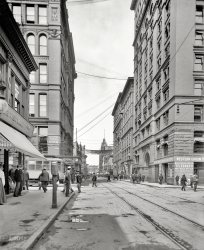
- Nurse Needles: 1942
- ... but the needles generally needed a touchup on the arkansas stone. Not every orderly had good honing skills.
Sweet Sue I'm ... Posted by Dave - 07/16/2014 - 10:48am -
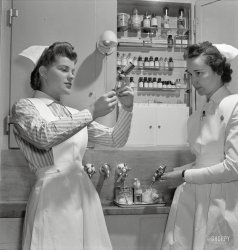
- Icing on the Coke: 1938
- ... a Farm Security Administration project near Altheimer, Arkansas." Medium format negative by Russell Lee for the FSA. View full size. ... Posted by Dave - 03/09/2018 - 4:00pm -
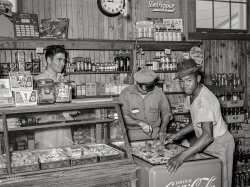
- Black and White: 1958
- ... via television during the period that the Little Rock (Arkansas) schools were closed to avoid integration." September 1958. View ... Posted by Dave - 08/26/2008 - 8:28pm -
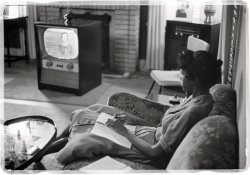
- Family Porchrait: 1939
- January 1939. Chicot Farms, Arkansas. "Husband and wife on porch of farm house." Photo by Russell Lee, Farm ... Posted by Dave - 06/24/2012 - 12:53pm -
![Family Porchrait: 1939 January 1939. Chicot Farms, Arkansas. "Husband and wife on porch of farm house." Photo by Russell Lee, Farm Security Administration. View full size.
New Home OwnershipI can feel the pride they have showing off their new home; all white and pretty. Are those some kind of manufacturer stickers on the window panes? You know, like Minnie Pearl's hat with price tag still attached.
Ma & Pa KettleAnd from the looks of that ax, Joan Crawford is probably lurking somewhere nearby.
Christmas lights?Those "stickers" in the window look like Christmas lights (which would be somewhat appropriate since it's January). It's hard to tell if they're really lights or just stickers.
Okay, I'm going with Christmas light stickers.
Just mucking aroundBesides fishing, you'd need the boots when doing the chores such as feeding the hogs or mucking out the stable. You wouldn't want to be stepping in that stuff with regular shoes. Also, Ms Hen might not be ready to meet her demise. On family farms, it would be the poorest layers who'd meet their doom first.
Uniroyal, Red Ball or LaCrosse?No signs of fishing equipment in the scene, so I wonder - why the hip boots?
Ms. Hen in the left background may be the guest of honor for that chopping block.
[I truly love old farm scenes.]
ElectricityIf these folks didn't have power for a radio, they probably didn't have power for Christmas lights.
Chopping blockBlock could most certainly be used on ms hen's neck, however, the block was most likely for chopping firewood.
A hatchet for the hen, an ax for the wood.
Hip BootsI have no idea why he's wearing those boots, but to SJBill's comment about fishing, it seems that Chicot Farms was/is located on Chicot Lake.
Boots on the groundBoot are a must have on a farm. Animal muck everywhere. I wore mine all the time. No worries and when you are done you can spray them with the hose before you take them off.
I tell young friends that my Mother didn't live in an electrified house until she was 20 and moved to Atlanta. They are dumb-founded. Rural electrification was a great thing. The electric company's would never have done it. To few customers to justify the lines.
Also, great dog!
Dawg on the left"I smell a cat around here somewhere..."
(The Gallery, Cats, Dogs, Russell Lee)](https://www.shorpy.com/files/images/SHORPY_8a24942a.thumbnail.jpg)
- My Party Dress: 1939
- ... after this photo. Her family was plenty poor in rural Arkansas, but did manage to stay home while her father left for out-of-state ... Posted by Dave - 04/26/2012 - 8:43pm -
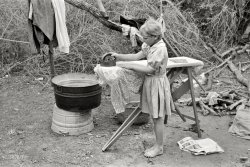
- Route 99: 1939
- ... during the Depression too as a migrant worker in the Arkansas-Oklahoma-Texas border area. An interesting aside: In the late 1960s ... when they emigrated to California from Oklahoma and Arkansas.
Particularly Sad There is something uniquely sad about this ... Posted by Dave - 05/21/2012 - 10:50pm -
![Route 99: 1939 February 1939. "On U.S. 99 near Brawley, Imperial County, California. Homeless mother and youngest child of seven walking the highway from Phoenix, Arizona, where they picked cotton. Bound for San Diego, where the father hopes to get on relief 'because he once lived there.'" Medium-format nitrate negative by Dorothea Lange for the Farm Security Administration. View full size.
Tough BeginningsThis baby would be somewhere between 73 and 75 today if she made it through those hardscrabble years and is still around. Hopefully life got better and she did experience more good times as the economy improved. I'd like to think there was sufficient joy in her life to bring about contentment and fulfillment as time went on. As for mom, as one elderly lady once told me "When your kids hurt, you hurt too." This mom's face does convey the pain of a struggle to take care of a family (as another child is visible in the extreme left margin) and reminds us that life is not always just a bowl of cherries.
[As noted in the caption, this lady had seven kids. - Dave]
Brawley=HotGood thing it's February, Brawley is nearly intolerable in the Summer.
Worn outThe baby is lucky to have shoes. My mother didn't own a pair until 1940 when she was 11. She picked a lot of cotton during the Depression too as a migrant worker in the Arkansas-Oklahoma-Texas border area. An interesting aside: In the late 1960s Mother asked us kids what "soul food" was. We told her. Her reaction was, "Soul food! That's poor people food and I've eaten enough of that."
Ummmm check on thisUS 99 never ran through Phoenix; it ran from the Mexican border in California to Blane, Washington. So she didn't walk US 99 from Phoenix as inferred in the note about the photograph. US 60 ran from the Arizona state line where it connected to US 70 to then connect to US 99. So she walked the highways, not highway.
Ms. Lange's unique styleShe never fails to reveal the deepest pathos of her subjects.
my heritageThis is what my grandparents endured as small children when they emigrated to California from Oklahoma and Arkansas.
Particularly SadThere is something uniquely sad about this obviously very poor woman wearing a worn fur coat. Does the coat imply she was in better financial position in the past? Was it purchased in a worn used state? One can only wonder.
(The Gallery, Dorothea Lange, Great Depression, Kids)](https://www.shorpy.com/files/images/SHORPY_8b33233u.thumbnail.jpg)
- Oops: 1905
- ... SYLVANIA was towed out of the Frog Pond by the harbor tugs ARKANSAS and WYOMING. She was handed over to the tug OHIO for delivery to the ... Posted by Dave - 08/21/2012 - 10:50am -
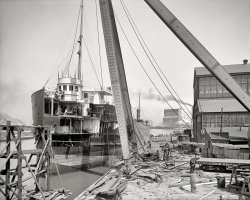
- Tough Enough: 1936
- ... home and connections in South Texas, and hope to reach the Arkansas Delta for work in the cotton fields. Penniless people. No food and ... Posted by Dave - 10/05/2012 - 6:22am -
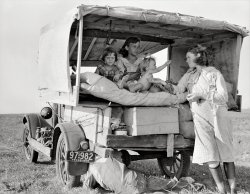
- Hot Springs: 1900
- Circa 1900. "Central Avenue, Hot Springs, Arkansas." Note the flowing tap in the foreground. 8x10 inch glass negative, ... Posted by Dave - 08/20/2012 - 3:19pm -
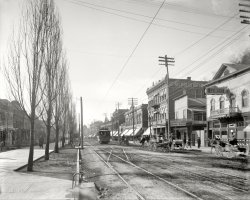
- Migrant Mother: 1940
- ... July 1940. Berrien County, Michigan. "Migrant woman from Arkansas in roadside camp of cherry pickers." 35mm nitrate negative by John ... Posted by Dave - 05/17/2011 - 8:09pm -
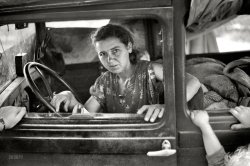
- Holdouts: 1935
- ... 1935. "One of the few remaining inhabitants of Zinc, Arkansas, deserted mining town." View full size. 35mm nitrate negative by ... Posted by Dave - 03/04/2008 - 2:53am -
![Holdouts: 1935 October 1935. "One of the few remaining inhabitants of Zinc, Arkansas, deserted mining town." View full size. 35mm nitrate negative by Ben Shahn.
That DogI love that dog in the background, lying on the porch just behind his shoulder. So perfect.
ZincOh my. Haunting.
ArrestingAs arresting for its composition and artistic merits as it is for its historical documentation. Very, very good.
My favouritesI have to say I am finding the photos from the 30's my favourites on this site. The portraits as just stunning and this is an outstanding example of this, at once touching and gritty. Please keep up the excellent work.
Zinc PicYeah, what the "Arresting" comment said. Wow. All this great stuff, and nooooo Photoshop. I am continually humbled by these.
Why can't our government fund anything worthwhile like this anymore? Can somebody please resurrect FDR for us?
[Photoshop CS3, in particular the CS3 Shadows & Highlights filter, is used on all of these photos. - Dave]
Native ZincanMy father was born in Zinc in 1938.
(The Gallery, Ben Shahn, Dogs, Small Towns)](https://www.shorpy.com/files/images/8a16234u.thumbnail.jpg)
- Crusty Schmidt: 1917
- ... father was an employee of Colonial Bakery in Fort Smith, Arkansas during WWII. The bakery provided bread for nearby Camp (later Fort, ... Posted by Dave - 08/26/2012 - 11:43am -
![Crusty Schmidt: 1917 "Camp Meade, Maryland, 1917." Harris & Ewing glass negative. View full size.
Mmm Crusty breadI'm guessing that "Crusty" is a good thing, back then anyway. BTW, put some air in those tires, will ya!
Look at those tires!Dear Lord, look at the tire on the truck. It appears to be solid rubber.
This means a bone-shaking jolt for the driver every time he runs over so much as a nickel.
Worse: the wheels will frequently be out of contact with the pavement, making skids far more likely than with pneumatic tires.
Having to lug 100-pound crates around may be the least of our nattily-dressed driver's issues.
Truck's wheelsI'm fascinated by the fact that the truck appears to have no tires. I haven't seen many (if any) trucks from this period. It must have been a nightmare to drive.
[The truck has solid rubber tires. - Dave]
Camp to FortI spent the last 6 months of my Army service during the Vietnam War at what was had been upgraded to "Fort" Meade, and was discharged in July 1967. At the time I was living with my wife in Arlington, Va., and commuted daily 40 miles each direction in my Renault Dauphine to make early formation.
Speed , not comfort I can't imagine the spine shattering ride on those tires.
Civilian breadCivilian Bread being delivered to the cook? When I was in during the Korean mess, all of our bread was made at the Fort Jackson Army bakery and always seemed to be day old. Got pretty used to it until one happy day the camp bakery broke down and they supplied us with "civilian" bread. Man, that was real eating and I have never forgotten that day. Yummmm!
Also, look at all those sacks of taters that some poor KPs are going to have to peel though I was never assigned to that detail. Fort Jackson (SC) used coal fired ranges while I was there that had to be cleaned once a week by rubbing them internally with brickbats so they would pass Saturday inspection.
Schmidt'sThe Schmidt Bakery is still around, though they no longer hawk "crusty bread". Started in 1886 by German immigrants, it is still family owned (run by their great-grandson) and has bakeries in Baltimore and Fullerton.
Schmidt's potato bread is, by the way, outstanding. Yum.
Bread for the troopsBread for soldiers from civilian sources is, or was not unusual. My father was an employee of Colonial Bakery in Fort Smith, Arkansas during WWII. The bakery provided bread for nearby Camp (later Fort, now closed) Chaffee. The draft board (or other authority) declared his job as essential to the war effort. As a result, he could not quit his job, the bakery could not fire him, he could not be drafted, nor could he volunteer for the Armed Forces. He was to bake bread for the duration of the war. Since gas was rationed tightly, he sold our car and rode a bicycle to work until the end of the war. He stayed with the bakery for a 49-year career.
Lift That BaleHere we have another guy in a necktie doing some heavy lifting. That crate looks like it's made of wood. His life could have been easier with some sort of cardboard or masonite container.
(The Gallery, Cars, Trucks, Buses, Harris + Ewing, WWI)](https://www.shorpy.com/files/images/09647a.thumbnail.jpg)
- Show Boat: 1900
- ... Eclipse in 1916. Lost on a snag in 1925 at Osceola, Arkansas.
(The Gallery, Boats & Bridges, DPC, Memphis) ... Posted by Dave - 08/02/2012 - 5:24pm -
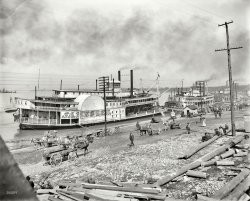
- Slice of Life: 1910
- Continuing our tour of Little Rock, Arkansas, circa 1910. "West 2nd Street residences." 8x10 inch glass negative, ... Posted by Dave - 08/08/2012 - 2:29pm -
![Slice of Life: 1910 Continuing our tour of Little Rock, Arkansas, circa 1910. "West 2nd Street residences." 8x10 inch glass negative, Detroit Publishing Co. View full size.
RetouchingI'll bet the Detroit Publishing Co. must have had to employ a retoucher just to airbrush out the road apples that show up in every street scene!
Whatzit? I'm wondering what that rope like thing is attached to the radiator cap. AN overflow hose perhaps? Or did it serve a function like letting steam or moisture drip into the calcium carbide to produce acetylene gas for the headlights.
The Whatzit RopeThe mystery rope is of course attached to a horse hobble, an iron weight you set on the ground to keep your horse from wandering off. The radiator cap must be deemed equivalent to a halter. I know this from a Laurel and Hardy movie.
Side crankThat Model F Buick is a two cylinder model with the crankshaft running across the frame. With that engine orientation the detachable crank fits into the end of the engine on the right side of the car, under the frame rail under the seat. A right side view of the car would tell if it's a 1908 or 1909. A very popular car in its day judging by the numbers one sees on Horseless Carriage tours these days.
The car looks quite advanced for 1910No crank start means it probably had an electric starter, and it had headlights.
[The hole for the crank is on the side. There were no electric starters until 1912. The headlights on this car, a circa 1908 Buick, use acetylene gas. The parking lights are kerosene lanterns. - Dave]
1908 BuickGreat photo. The car looks like a Buick, around 1908. Lots of hitching posts. I think those concrete "blocks" to the right of the car must be to help people get out of their carriage or car.
[They're called mounting blocks. Good work identifying the car. The grille has been de-blinged. - Dave]
(The Gallery, Cars, Trucks, Buses, DPC, Little Rock)](https://www.shorpy.com/files/images/4a23594a.thumbnail.jpg)
- Wel-Mart: 1940
- ... office in rear of country store. Faulkner County, Arkansas." Acetate negative by Marion Post Wolcott for the Farm Security ... Posted by Dave - 04/10/2021 - 2:00pm -
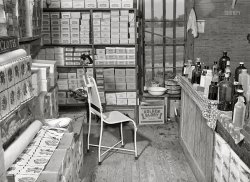
- Hello, Internet: 1935
- October 1935. Cotton picker in Pulaski County, Arkansas. View full size. 35mm nitrate negative by Ben Shahn for the Farm ... Posted by Dave - 01/07/2008 - 12:42am -
![Hello, Internet: 1935 October 1935. Cotton picker in Pulaski County, Arkansas. View full size. 35mm nitrate negative by Ben Shahn for the Farm Security Administration.
Pulaski Cotton PickerThanks Dave for your wonderful blog. This is a great photo. My grandmother has many stories of picking cotton as a child - this helps to visualize it.
[You're welcome. For a fieldworker, this lady has class. Stylish hat, regal bearing. God knows what she thought of Ben Shahn and his funny little camera. So what did your grandma have to say about working in cotton? - Dave]
This is a beautiful woman!This is a beautiful woman!
Pulaski Cotton PickerOh the stories my grandmother can tell about growing up in the Cane River area of Natchitoches parish in Louisiana. She lived a rural life with no indoor plumbing, no electric or gas appliances, and no easy access to a doctor.
According to her cotton was a horrible crop to harvest. The boll is thorny and rips up your hands. Cotton harvesters were paid by the pound - cotton being fairly light, you have to pick a lot of it to make some money. She told me that they would pack a sack with dry cotton at the bottom and top - with the middle soaking wet to increase the weight (but not soak through the bag).
Cotton aside, she talks fondly about her dad's pecan grove, a mysterious fruit called a "ze-ze" that she said she has never seen outside of Cane River, and the rituals around butchering a steer, pig, or goat on special days. She was poor, but happy and never hungry.
These are wonderful stories for me - I'm a city born and raised man here in Los Angeles. The photo illustrates much of what she has tried to convey. Thanks again Dave.
Beautiful WomanHave to agree, very beautiful indeed.
Lovely Woman!Class personified. Stylish woman with beautiful skin and great clothes. Looking good!
(The Gallery, Agriculture, Ben Shahn, Rural America)](https://www.shorpy.com/files/images/8a16160u_0.thumbnail.jpg)
- Royal Gorge: 1900
- Colorado circa 1900. "In the Royal Gorge, Arkansas River, Rio Grande Southern Railway." 8x10 glass negative by William ... Posted by Dave - 12/12/2013 - 12:23pm -
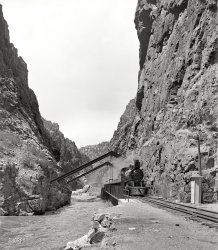
- Farm to Table: 1939
- ... now to think back when I was a USDA poultry inspector in Arkansas for a couple of years. And where did we go for lunch more often than ... Posted by Dave - 02/27/2017 - 10:44am -
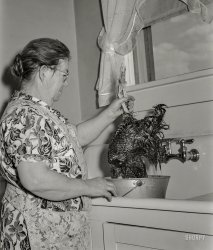
- Snowbirds: 1900
- Circa 1900. "Ostrich farm -- Hot Springs, Arkansas." Careful, these birds are "dangereous." 8x10 glass negative, Detroit ... Out of place I seriously doubt this photo was taken in Arkansas. My cousin told me those are actually Texas chickens.
Ostriches ... Posted by Dave - 12/06/2013 - 12:12pm -
